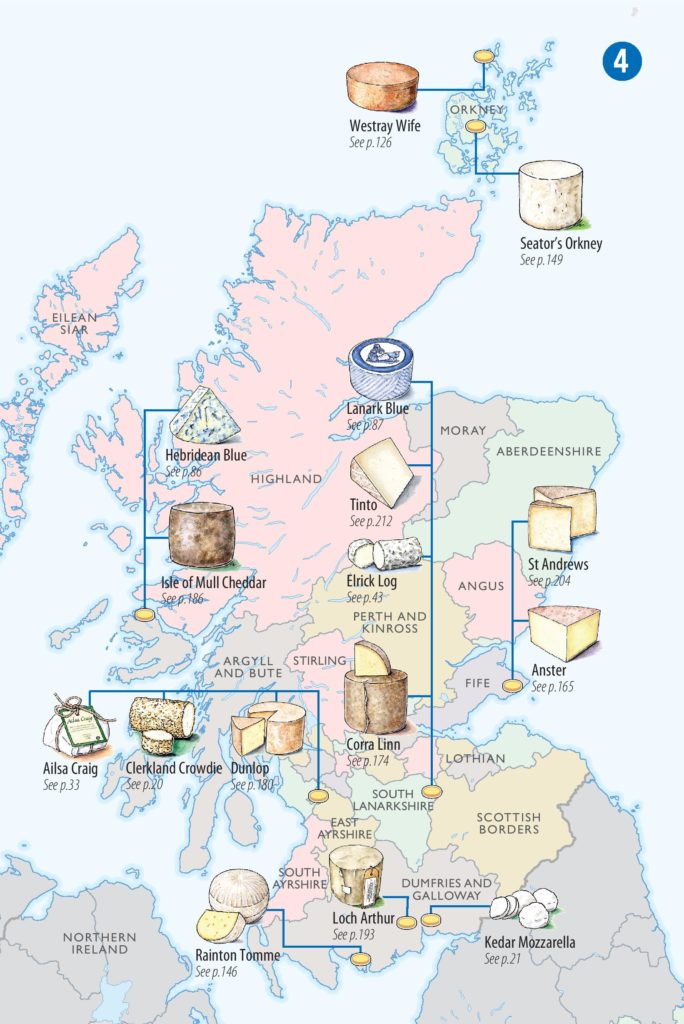It sounds like Ned Palmer had a better lockdown than most of us.
This fromage expert and author used most of the time stuck at home to research his book, A Cheesemonger’s Compendium of British and Irish Cheese, which is out now and features 158 cheeses. It’s a companion to his 2019 book, A Cheesemonger’s History of the British Isles.
“The first was a narrative, with the story starting in 6000BC and finishing now”, says Palmer, who set up the Cheese Tasting Company in 2014. “This one is a treasury because a list sounds boring and I don’t think it’s boring. As well as describing my favourite cheeses, it’s practical so it offers advice on how to choose cheese, how to buy it, which shops to go to, how to taste it, how long to keep it and selecting the right ones for a cheeseboard, as well as a bit about cooking with it. These are the things people really want to know, so they can buy and eat more”.
While writing the new book, Palmer and his wife would start nibbling from the crack of dawn onwards. There were no crackers, bread or chutney - just neat cheese for breakfast.
The couple had to work their way through deliveries including those from some of the best Scottish cheesemongers, including IJ Mellis and George Mewes.
“I realised I needed to taste about 100 new cheeses. In the first book there’re about 50 and I know them very well”, says Palmer. “Research for the new one involved getting cheese sent to me from all over Britain and Ireland, and for some reason I’d taste them at seven in the morning - some really gnarly cheese, which was quite something. I had a nice chat with Rory Mellis and he sent me a big box. I ordered ones I already wanted but also asked him to recommend others he thought were really great”.
The 16 Scottish products that made it into the book are scattered among the six colour-coded sections, each of which represents a “family” of cheese: Fresh, Mould-ripened, Blue, Washed-rind, Semi-Soft and Hard.
“I wanted to showcase some newer cheese that people wouldn’t have heard of so much”, says Palmer. “Westray Wife, in Orkney, is a washed rind cheese - those pink sticky ones - and is quite pungent. It’s absolutely cracking. Jane Stewart makes St Andrew’s Cheddar and Anster in Fife. They both really have their own unique character”.
Palmer also had his first taste of Hebridean Blue which is made by the Reid family who also produce Isle of Mull cheddar.
“It’s hefty and I love hefty things. It made me chuckle with how powerful it is, “ says Palmer, who says he sees an increasingly wide demographic of people who are into artisan cheese these days. “In terms of terroir, it’s got its own character, like a person. You imagine that people from Isle of Mull are quite tough, like the cheese”.
In the book, the author includes detailed tasting notes about each variety.
“The longer lockdown went on, the more florid my descriptions became”, says Palmer, who described Hebridean Blue as “offering a muted maltiness, like an empty biscuit barrel”.
“Corra Linn is really lovely sheep’s milk cheese, and I think I described it as tasting like buttered popcorn, candy floss and hay, with a bit of honeycomb,” says Palmer.
This cheese is produced by the Errington family, who also make Lanark Blue, which, of course, is included in the book.
“Humphrey Errington is one of the heroes of the British and Scottish cheese renaissance, he started making in the early Eighties and Lanark Blue was always the famous cheese,” says Palmer. “His daughter Selina has taken over and they’re making loads more, like the Elrick Log which is a lovely goat’s cheese log and Blackmount, a goat’s cheese pyramid”.
Palmer also noticed, while researching, the effect that terroir - a term often used in the wine world - has on cheese. For example, while Somerset Cheddar is a sunset yellow colour, Isle of Mull Cheddar is pale, because they feed the cows the barley mash from whisky making and the grass is different in the cooler climate. He also thinks they vary from our east to west coasts, so St Andrews Cheddar has a slightly darker colour, again due to the weather differences.
Palmer thinks the next big trend, along with genre blending post-modern cheeses, is the rise of territorials. These are cheeses that are named and associated with the places they’re made. In Scotland, we have Dunlop. In the rest of the UK, there’s Lancashire, Cheshire, Double Gloucester and Wensleydale, with several new producers.
“They’re all cow’s milk and they’re usually quite mild and crumbly. They’re unique, nobody else in the world makes them, but nobody has heard of the phrase territorials and we should know. They’re wonderful”, says Palmer. “It’s one of the styles that’s suffered due to supermarkets and industrial cheese-making. They don’t lend themselves to being made in a factory because they’re very mild. Unless you’re doing the handmade thing, have happy healthy animals and good grass, they don’t taste of much”.
Dunlop is also one of the cheeses that would make it onto Palmer’s ideal Scottish cheeseboard, along with St Andrews or Isle of Mull Cheddar, Lanark Blue and Ailsa Craig.
No carbs on the side. As he says, “I don’t have crackers or bread at all, because I’m just such a cheese geek”.
A Cheesemonger’s Compendium of British and Irish Cheese by Ned Palmer, with illustrations by Claire Littlejohn, Profile Books, £14.99


